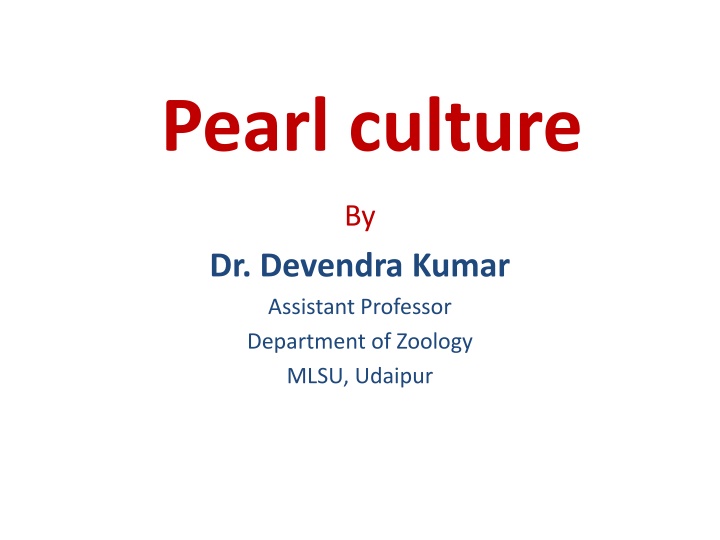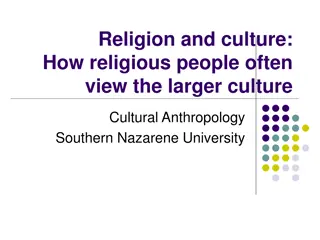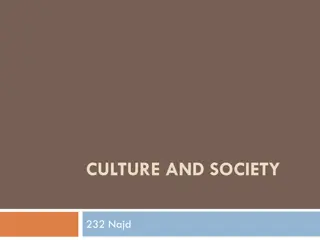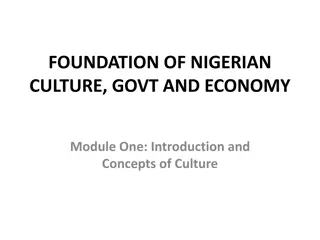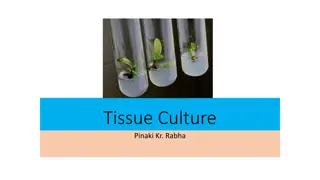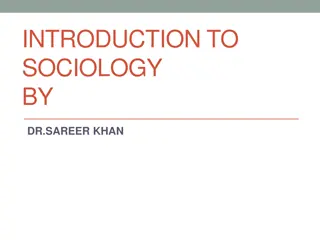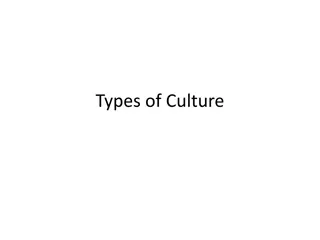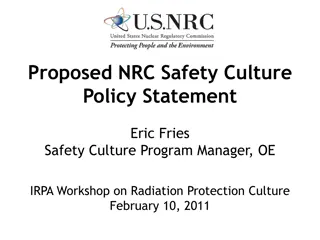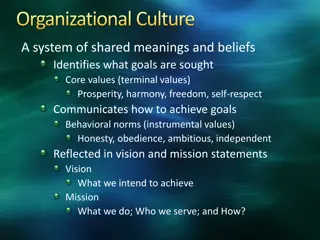History and Culture of Pearls: A Comprehensive Overview by Dr. Devendra Kumar
Discover the intriguing world of pearl culture and history as Dr. Devendra Kumar, Assistant Professor of Zoology at MLSU, Udaipur, delves into the origins, significance, and production of pearls. From the natural rarity of pearls to the growth of cultured pearl farming, explore the historical ties between humans and pearls, including their symbolic value and economic impact throughout the ages.
Download Presentation

Please find below an Image/Link to download the presentation.
The content on the website is provided AS IS for your information and personal use only. It may not be sold, licensed, or shared on other websites without obtaining consent from the author.If you encounter any issues during the download, it is possible that the publisher has removed the file from their server.
You are allowed to download the files provided on this website for personal or commercial use, subject to the condition that they are used lawfully. All files are the property of their respective owners.
The content on the website is provided AS IS for your information and personal use only. It may not be sold, licensed, or shared on other websites without obtaining consent from the author.
E N D
Presentation Transcript
Pearl culture By Dr. Devendra Kumar Assistant Professor Department of Zoology MLSU, Udaipur
PEARL CULTURE INTRODUCTION A pearl is a hard object produced within the soft tissue of a living shelled mollusk. Just like the shell of a mollusk, a pearl is made up of calcium carbonate, which has been deposited in concentric layers. The ideal pearl is perfectly round and smooth, but many other shapes of pearls also occur. The finest quality natural pearls have been highly valued as gemstones and objects of beauty for many centuries, and because of this, the word pearl has become a metaphor for something very rare, fine, admirable, and valuable.
The most valuable pearls occur spontaneously in the wild, but they are extremely rare. Cultured or farmed pearls from pearl oysters make up the majority of those that are currently sold. Pearls from the sea are valued more highly than freshwater pearls. Imitation or fake pearls are also widely sold in inexpensive jewellery, but the quality of their iridescence is usually very poor, and generally speaking, artificial pearls are easily distinguished from genuine pearls. Pearls have been harvested and cultivated primarily for use in jewellery, but in the past they were also stitched onto lavish clothing. Pearls have also been crushed and used in cosmetics, medicines, and in paint formulations.
HISTORY OF PEARLS Pearls are closely linked to humans since prehistoric time. Evidences suggest that, pearl shells were used as decorative objects during ancient times in Egypt. Pearls re also featured in religious texts like Bible and Koran. Also the origin of pearls is explained in mythological and cosmological terms. During the reign of Alexander the Great there was a marked increase in the trade and transport of pearls to the Western world from the Red Sea and the Middle East. Pearls were symbolic of power and purity during the middle Ages and many royals adorned themselves with pearl jewels.
An important period in pearl history were the first voyages of Christopher Columbus and other Spaniards in the 15thand 16thcenturies when they discovered pearls and pearl oyster banks in Central and South America. This generated great wealth for the Spanish crown and triggered what is known as the Pearl Age amongst European royals and aristocrats. Although there were numerous attempts at culturing pearls, the first to successfully achieve this feat and market a product was Mikimoto using the Mise- Nishikawa method in 1916. With the help of Japanese expertise cultured pearl farming expanded to other countries. Affordability of cultured pearls led to gradual demise of the natural pearl trade from the 1920s onwards.
PEARL OYSTERS FOR CULTURE Six species of pearl oysters occur along the Indian coasts, Pinctada fucata (Gould) Pinctada margaritifera (Linnaeus) Pinctada chemnitzii (Philippi) Pinctada sugillata (Reeve) Pinctada anomioides (Reeve) Pinctada atropurpurea (Dunker)
DISTRIBUTION OF PEARL OYSTERS Pearl oysters of the genus Pinctada are cosmopolitan in distribution. They occur in several seas of the tropical belt and in the sub-tropical region. Although a number of species of pearl oysters have been identified, only a few have been found to produce pearls of good quality with commercial value. In the Indian waters six species of pearl oysters occur but only P. fucata has contributed to the pearl fisheries in the Gulf of Mannar and Gulf of Kutch.
PEARL CULTURE IN INDIA Pearls have been known to mankind since the beginning of civilization. They are highly esteemed as gems for their beauty and splendour. These structures are secreted by the mantle (i.e., the skin) of pearl oysters in response to irritations caused by external or internal stimuli such as sand grains, mollusc eggs, parasites, detritus, and other foreign particles. Many attempts have been made to culture pearls in freshwater mussels. India has one of the highest demands for pearls for setting in jewellery. The pearl oyster fisheries are located in two main areas: 1) The Gulf of Mannar of Tuticorin coast and 2) The Gulf of Kutch on the northwest coast
The pearl oysters are found in two different environments in two localities, at depths up to 23 meters in the Gulf of Mannar, in the intertidal zone in the Gulf of Kutch. These bivalves form large beds on hard substrata in the Gulf of Mannar, while they are sparsely distributed in the Gulf of Kutch. The pearl oyster resources in the two areas have been fished for pearls until the early 1960's. The techniques of pearl oyster farming and pearl culture are not widely known. In India, interest in pearl culture began at the start of this century.
Several studies have been conducted by the Madras Fisheries Department in the 1930s. In 1972, the Central Marine Fisheries Research Institute (CMFRI) took up intensive research on pearl culture at Tuticorin achieving a breakthrough in July 1973 when it produced free spherical cultured pearls by employing the mantle graft implementation technique. The development of the pearl oyster hatchery technology in India in 1981 opened the way for large and commercial scale culture of this bivalve species. Based on the technical know-how provided by the CMFRI, a company has been established at Tuticorin to produce cultured pearls.
TECHNICAL REQUIREMENTS FOR PEARL CULTURE The technical requirements for establishment of Pearl farm and its successful operation are briefly described below:
PROCESS OF PEARL CULTURE The process of pearl culture includes the following steps which are very crucial for obtaining high grade of pearls with good commercial value.
Step 1: Construction of pearl farm Construction of a pearl farm includes three steps. They are, Selection of farm site Construction of farm Well-planned work schedule
Selection of farm site: This step determines the type of pearls produced, and the oyster survival rate. Some of the points to be noted while selecting the site are: * Natural features like mountains and reefs are needed to protect the farm from winds, currents, storms, etc. * Constant regularity of temperature * Type of sea bed, such as rocky or sandy. * Gentle currents are essential for the survival of the oysters as they bring food and oxygen.
Construction of pearl farm: The whole pearl farm system is based on series of floating wooden rafts. Ten units of wooden rafts are used. Each raft consists of two to five pieces of wood making the total length to 20 ft. The raft is covered with wire mesh baskets, each of which house 10 oysters.
Well-planned work schedule: A typical work schedule plays a very critical role in pearl culture. The timing for collecting and seeding the oysters must be scheduled and followed strictly.
Step 2: Collecting oysters After the construction of pearl farm, the divers set out to the bottom of the sea, to collect the oysters. Divers are pulled by large lugger boats in the direction of the tidal flow. Oysters are generally located on a flat rock bottom and are usually covered with marine animals and a thin layer of silt. Therefore, it is often very difficult for divers to recognise them. The shells collected, are cleaned, sized, and placed into baskets for storage until they are transferred to the pearl farm.
Step 3: Seeding Two-three year old healthy considered for surgical implantation known as seeding. This is a very delicate operation and involves three stages: oysters are
Preparation of the graft: A donor oyster is sacrificed to obtain mantle. Mantle is needed by the host oyster to accept the nucleus. The mantle is located on the outer section of the oyster and Mantle produces the nacre which forms pearl. Before a graft is taken from the mantle, the oysters are starved for several days to slow down the metabolism of the oyster. This helps to decrease the risk of core rejection and open the oyster easily.
Attaching the graft: The oyster is opened with special wedges and pliers, then a scalpel slit is made in the soft tissue near the reproductive organ and a graft of living mantle is inserted into the slit.
Inserting the core: A nucleus is placed in the scalpel slit and the oyster is then returned back to the water. The inserted core irritates the oyster, provoking it to gradually coat the core with thin layers of mother of pearl nacre. After some time, the oysters are collected, and x-rayed to see whether the implants have been accepted. Oysters which have rejected the implant are returned to the water and are once again operated. The oysters which have accepted the implant are transferred to the pearl farm. The person who is seeding must be extremely careful not to harm the tiny pea-crab which lives unharmed within every healthy oyster. It is presumed that the crab assists the oyster by keeping it clean and by sharing the debris which the oyster sucks in.
Step 4: Caring the oyster The shells which have been collected and transferred to the pearl farm are placed in baskets or panels which are attached to long lines connected to the floating rafts. The rafts are dropped down into the ocean with the oyster securely inside the basket, where they remain until they become operated on for further seeding. The oyster can produce more than one pearl in its lifetime. Regular cleaning of the shells to remove seaweed results in better pearls plus makes them easier to handle. The cleaning is done by a machine which uses water jets and brushes to clean off any seaweed. The oysters need very tender loving care so as to be productive when harvested.
Harvesting After 2-3 years, the oysters are harvested. It is necessary to make a trial harvest to determine whether the pearls have a sufficient coating. If it is not sufficient then an additional six months to a year of culturing is necessary. The oysters are split open and pearl bags are cut by the scalpel to remove the pearls. Collected pearls should be thoroughly dried after the harvest to prevent loss of luster.
Sorting pearls There are many different steps involved with the sorting of pearls. Firstly, the pearls are sorted according to whether they can be used for the cultured pearl industry or not. These are categorized into three sections: Unmarked pearls Pearls with one major blemish Pearls with more than one major blemish
Prospect of Pearl Fishery: Pearl fishery in India has a great prospect as compared with other pearl producing countries that have occupied the world s pearl market. In India the artificial pearl production has started at the Tuticorin Research Centre of CMFRI (Central Marine Fisheries Research Institute) with the collaboration scheme of the Tamil Nadu State Fisheries Department. In 1975, K. Alagaswami has proved that the growth rates of pearls is much faster in India than that of Japanese Sea.
Enemies of Pearl Oysters: Natural enemies of pearl oysters are octopus (devil fish), barnacles, eel, etc. In addition low salinity of the water caused by the heavy rains and red tide are also dangerous to the pearl oysters. Sometimes growth of sea weeds and barnacles kill many oysters.
